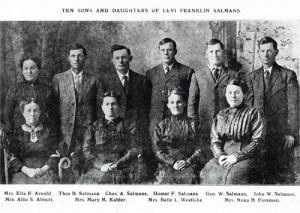War asks for sacrifices. It seems to be the way the game is played. Some are asked to give their lives, others their childrens’ lives. Where you live, how you live, with whom you live changes in war. For my grandparents,Elzie and Vera Chenoweth, many of these things changed for them during World War II.
Grandpa and Grandma lived on the family farm in Fulton county, Illinois as had Grandpa’s father, grandfather and great grandfather before him. The Chenoweth family had moved to Illinois in the mid 1850’s and began farming near Table Grove, Illinois. Not quite 100 years later, that farm house, barns and fields were under attack. No Nazi German or Hirohito’s Japanese had invaded western Illinois. It was the United States federal government who would take the farm from my grandparents.

William and Martha Jones Chenoweth homestead near Table Grove, Illinois. Circa 1880s. Pictured are their children in front of the home. This house and farm would be torn down in the 1940s to make way for the US Army Camp Ellis.
In 1942, the government was looking at land in order to build a military camp. Western Illinois offered just the spot. Camp Ellis was soon on the map to be constructed from the farmland, however, the problem was buying up of the land and getting the people to move somewhere else.
Grandpa and Grandma were told what the price would be they would be paid for their land. They held an auction of their equipment. While they were trying to quickly move out, the government came in, tearing down the barn almost over their heads. The farm house came down. Five generations of my family were born in that house. Fields were tore up and shooting ranges replaced timber ravines. Things changed swiftly.
My grandparents moved to a nearby community and bought a farm to begin farming again. The young man who worked for them on the farm had reported to military service and later died just a few days after D Day. The family that had always lived within a mile or two of each other were now scattered to the four winds. Things changed.
My grandparents changed in many ways, yet they never were bitter about losing the farm to the war effort. They felt others had sacrificed more. Their sacrifice was close to home. It WAS their home.
Postscript: In the mid 1950’s, Camp Ellis was abandoned by the federal government and families had the opportunity to repurchase land originally owned by them. My dad still owns an original 40 acres from one of these farms.



